26 pages • 52 minutes read
William SaroyanThe Summer of the Beautiful White Horse
Fiction | Short Story | YA | Published in 1940A modern alternative to SparkNotes and CliffsNotes, SuperSummary offers high-quality Study Guides with detailed chapter summaries and analysis of major themes, characters, and more.
Summary and Study Guide
Summary: “The Summer of the Beautiful White Horse”
“The Summer of the Beautiful White Horse,” a short story by William Saroyan, is part of a collection of Saroyan’s short stories called My Name is Aram, which was first published in 1940. Themes present in the story include Gentleness Versus Force, Truth and Honesty, which entails acting from one’s heart, and Duality and the Immigrant Experience, particularly in the lives of the Armenian immigrants about whom Saroyan writes.
The guide refers to the version of “The Summer of the Beautiful White Horse” published in William Saroyan’s collection of short stories, My Name is Aram, by Dover Publications, Inc. in 2013.
Aram Garoghlanian, a nine-year-old boy of Armenian descent who lives on the edge of a town in the San Joaquin Valley of California, is woken up early one morning by his older cousin Mourad, who is outside Aram’s window sitting on a beautiful white horse. Mourad invites him for a ride, which has been one of Aram’s longtime dreams. However, Aram’s extended family is desperately poor, so he doesn’t understand how Mourad got the horse. Their family also has a longstanding reputation for honesty, so Aram finds it hard to believe that Mourad would steal, though he admits to himself that Mourad must have done so. Aram rationalizes that a theft isn’t really a theft if one plans on returning the stolen item instead of selling it for money. He further justifies it with reference to his and Mourad’s love of horses.
Aram puts on some clothes and goes for a ride with Mourad, reflecting on how “crazy” his cousin Mourad is—second only to their uncle Khosrove, who always interrupts others by roaring, “It is no harm; pay no attention to it” (4). Aram and Mourad ride out into the beautiful countryside as Mourad sings loudly.
Mourad suddenly asks Aram to get off the horse so that he can ride alone. Aram says he also wants to ride alone, and Mourad states that the horse can decide. First, though, Mourad takes his own turn: He tells the horse, in Armenian, to run, and it gallops across the fields. When Aram takes his turn, he struggles to get the horse to move. After it takes off, Aram is thrown, and the horse continues running.
Mourad is more worried about capturing the horse than he is about Aram. When Mourad brings the horse back, he says that he knows a place to hide the horse until the next morning. It dawns on Aram that Mourad has been riding the horse for many days or weeks prior to this morning. However, when he asks Mourad about this, Mourad claims that this morning was his first ride. When Aram presses him, Mourad says he doesn’t want Aram to have to lie if they are caught. They hide the horse in a barn located in a deserted vineyard, and as they walk home, Mourad describes how he tamed the horse simply by having an honest relationship with it.
That afternoon, the Garoghlanians’ neighbor, a farmer named John Byro, visits Aram’s home and complains that his horse has been missing for a month. Khosrove, in his usual manner, yells at him. Aram overhears them and later goes looking for Mourad. He finds his cousin sitting under a tree helping a hurt robin. He tells Mourad what he heard, suggesting that they keep the horse for a year so that Aram has time to learn how to ride. The insinuation that he would “steal” a horse for an entire year angers Mourad, who instead thinks that six months is a reasonable time to keep the horse.
Aram and Mourad continue riding the horse each morning. Aram tries to ride like his cousin does, but the horse continues to throw him. One day while out riding, the boys meet John Byro, the owner of the horse. Mourad says that he’ll handle the situation, as he has “a way with farmers” (10). John Byro looks at the horse, peering into its mouth, and says, “I would swear it is my horse if I didn’t know your parents. The fame of your family for honesty is well known to me. Yet the horse is the twin of my horse” (10). He then leaves the boys.
The next morning, Aram and Mourad take the horse to John Byro’s barn. Later that day, he pays a visit to the Garoghlanian family in his surrey, pulled by the beautiful white horse, who he claims was stolen and then returned. He tells the family in amazement that the horse is better tempered than ever. From the other room, Uncle Khosrove yells, “Quiet, man, quiet. Your horse has been returned. Pay no attention to it” (11).
Related Titles
By William Saroyan



